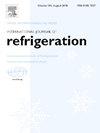Experimental improvement of a CO2 transcritical cycle using parallel compressor and integrated subcooler
IF 3.5
2区 工程技术
Q1 ENGINEERING, MECHANICAL
International Journal of Refrigeration-revue Internationale Du Froid
Pub Date : 2025-03-20
DOI:10.1016/j.ijrefrig.2025.03.019
引用次数: 0
Abstract
Due to the low critical temperature of Carbon Dioxide (CO2), the simplest CO2 transcritical refrigeration cycle is usually upgraded with different configurations to enhance the performance, increase the cooling capacity, and reduce the flash-gas generated during the expansion process. Considering this, different arrangements were proposed over time with excellent results but rarely compared in a unique refrigeration plant. The present work experimentally analyses and compares three-cycle arrangements for CO2 transcritical cycles, adding an internal heat exchanger (IHX), a parallel compressor, and an integrated subcooler.
Taking the IHX arrangement as a reference, the parallel compression and the integrated subcooler are compared at the heat rejection temperatures of 20, 27, and 34°C for commercial refrigeration purposes. The combination of parallel compressor and IHX provides maximum coefficient of performance (COP) and cooling capacity improvements of 3.6 % and 18.5 %, respectively, while the combination of integrated subcooler and IHX boosts the COP and the cooling capacity by up to 11.0 % and 19.5 %, respectively. The results demonstrate the convenience of using these configurations, fairly comparing arrangements with the same refrigerating plant.
采用并联压缩机和集成过冷却器的CO2跨临界循环实验改进
由于二氧化碳(CO2)的临界温度较低,通常对最简单的CO2跨临界制冷循环进行升级,采用不同的配置来增强性能,增加制冷量,减少膨胀过程中产生的闪焰气体。考虑到这一点,随着时间的推移,提出了不同的安排,效果很好,但很少在一个独特的制冷装置中进行比较。目前的工作实验分析和比较了二氧化碳跨临界循环的三循环安排,增加了一个内部热交换器(IHX),一个并联压缩机和一个集成过冷却器。以IHX布置为参考,在商业制冷散热温度为20℃、27℃和34℃时,对并联压缩和一体化过冷器进行了比较。并联压缩机和IHX组合的最大性能系数(COP)和制冷量分别提高了3.6%和18.5%,而集成过冷器和IHX组合的COP和制冷量分别提高了11.0%和19.5%。结果表明,使用这些配置的便利性,公平地比较安排与相同的制冷装置。
本文章由计算机程序翻译,如有差异,请以英文原文为准。
求助全文
约1分钟内获得全文
求助全文
来源期刊
CiteScore
7.30
自引率
12.80%
发文量
363
审稿时长
3.7 months
期刊介绍:
The International Journal of Refrigeration is published for the International Institute of Refrigeration (IIR) by Elsevier. It is essential reading for all those wishing to keep abreast of research and industrial news in refrigeration, air conditioning and associated fields. This is particularly important in these times of rapid introduction of alternative refrigerants and the emergence of new technology. The journal has published special issues on alternative refrigerants and novel topics in the field of boiling, condensation, heat pumps, food refrigeration, carbon dioxide, ammonia, hydrocarbons, magnetic refrigeration at room temperature, sorptive cooling, phase change materials and slurries, ejector technology, compressors, and solar cooling.
As well as original research papers the International Journal of Refrigeration also includes review articles, papers presented at IIR conferences, short reports and letters describing preliminary results and experimental details, and letters to the Editor on recent areas of discussion and controversy. Other features include forthcoming events, conference reports and book reviews.
Papers are published in either English or French with the IIR news section in both languages.

 求助内容:
求助内容: 应助结果提醒方式:
应助结果提醒方式:


